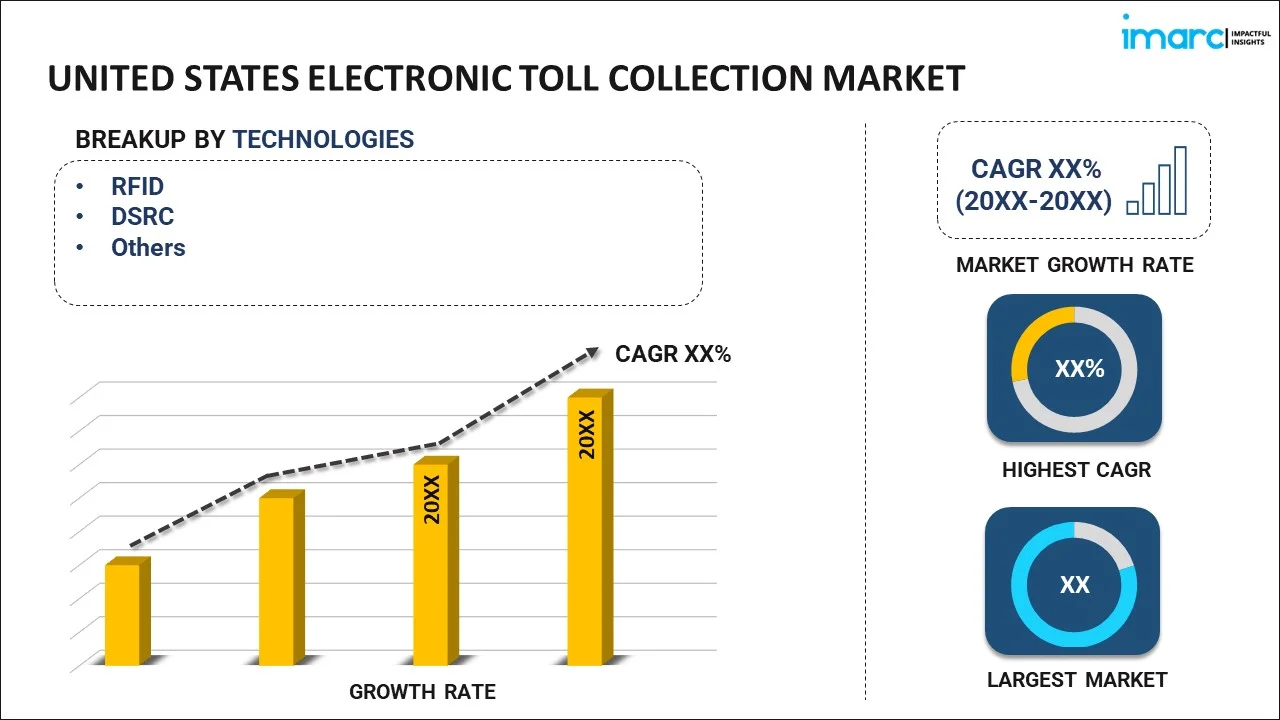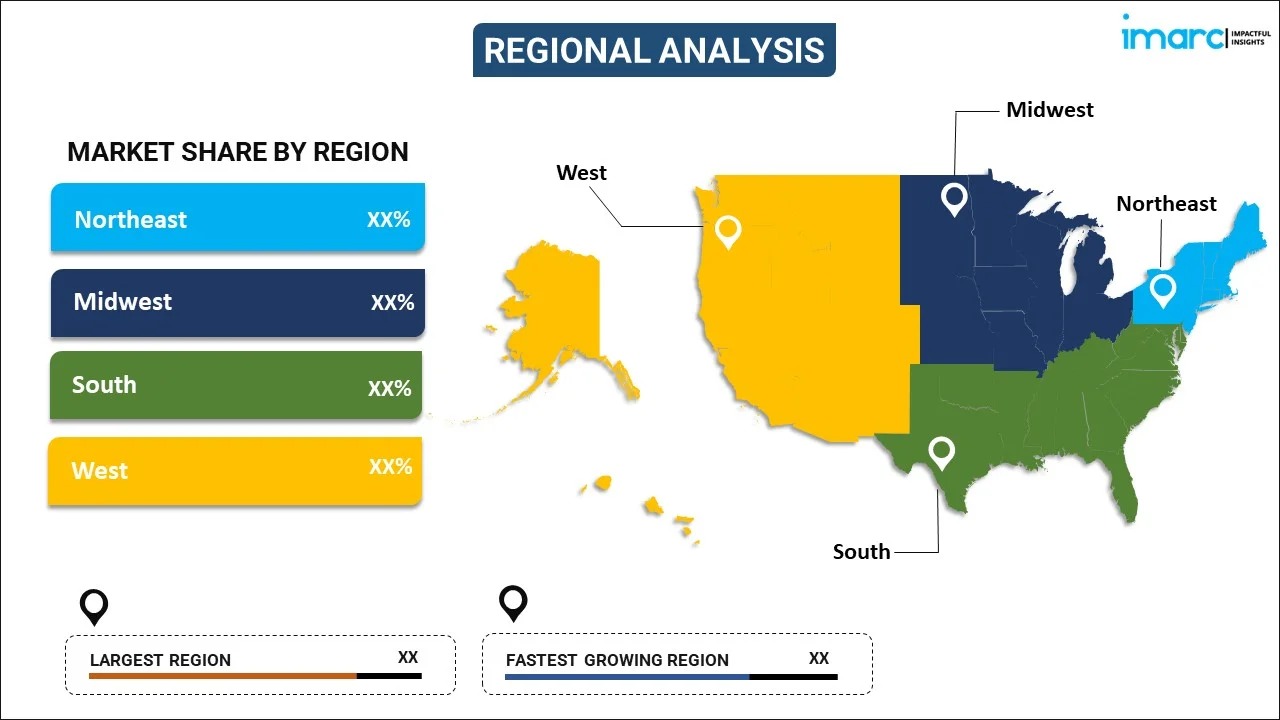
United States Electronic Toll Collection Market Report by Technology (RFID, DSRC, and Others), System (Transponder-or Tag-Based Toll Collection Systems, Other Toll Collection Systems), Subsystem (Automated Vehicle Identification, Automated Vehicle Classification, Violation Enforcement System, Transaction Processing), Offering (Hardware, Back Office and Other Services), Toll Charging (Distance Based, Point Based, Time Based, Perimeter Based), Application (Highways, Urban Areas), and Region 2025-2033
Market Overview:
The United States electronic toll collection market size reached USD 3.3 Billion in 2024. Looking forward, IMARC Group expects the market to reach USD 6.8 Billion by 2033, exhibiting a growth rate (CAGR) of 7.8% during 2025-2033.
|
Report Attribute
|
Key Statistics
|
|---|---|
|
Base Year
|
2024
|
|
Forecast Years
|
2025-2033
|
|
Historical Years
|
2019-2024
|
|
Market Size in 2024
|
USD 3.3 Billion |
|
Market Forecast in 2033
|
USD 6.8 Billion |
| Market Growth Rate 2025-2033 | 7.8% |
Electronic toll collection (ETC) is an automated system that utilizes automatic vehicle classification (AVC), violation enforcement system (VES) and automatic vehicle identification (AVI) to recognize registered vehicles and perform electronic monetary transactions. It also saves travel time, offers a cashless facility, minimizes congestion and facilitates transaction speed. Nowadays, ETC systems are integrated with video analytics, radio-frequency identification (RFID), dedicated short-range communications (DSRC), global navigation satellite system (GNSS) and global positioning system (GPS) technologies to improve the speed and efficiency of traffic flow in the United States.
The rising population and the increasing on-road vehicles lead to congestion at toll plazas on highways and roads. This, in confluence with the developed logistics and transport infrastructure, represents one of the key factors increasing the adoption of ETC systems in the United States. Apart from this, these systems aid in tracking stolen automobiles and managing over-speeding vehicles, which is acting as another major factor bolstering the market growth. Furthermore, the US Government is planning on utilizing revenue from toll collection in the development of highway infrastructure. This, along with the growing focus on smart transportation systems, is anticipated to drive the market in the coming years.
Key Market Segmentation:
IMARC Group provides an analysis of the key trends in each sub-segment of the United States electronic toll collection market report, along with forecasts at the country and regional level from 2025-2033. Our report has categorized the market based on technology, system, subsystem, offering, toll charging and application.
Breakup by Technology:

- RFID
- DSRC
- Others
Breakup by System:
- Transponder-or Tag-Based Toll Collection Systems
- Other Toll Collection Systems
Breakup by Subsystem:
- Automated Vehicle Identification
- Automated Vehicle Classification
- Violation Enforcement System
- Transaction Processing
Breakup by Offering:
- Hardware
- Back Office and Other Services
Breakup by Toll Charging:
- Distance Based
- Point Based
- Time Based
- Perimeter Based
Breakup by Application:
- Highways
- Urban Areas
Breakup by Region:

- Northeast
- Midwest
- South
- West
Competitive Landscape:
The competitive landscape of the industry has also been examined along with the profiles of the key players.
Report Coverage:
| Report Features | Details |
|---|---|
| Base Year of the Analysis | 2024 |
| Historical Period | 2019-2024 |
| Forecast Period | 2025-2033 |
| Units | Billion USD |
| Segment Coverage | Technology, System, Subsystem, Offering, Toll Charging, Application, Region |
| Region Covered | Northeast, Midwest, South, West |
| Customization Scope | 10% Free Customization |
| Post-Sale Analyst Support | 10-12 Weeks |
| Delivery Format | PDF and Excel through Email (We can also provide the editable version of the report in PPT/Word format on special request) |
Key Questions Answered in This Report
The United States electronic toll collection market was valued at USD 3.3 Billion in 2024.
We expect the United States electronic toll collection market to exhibit a CAGR of 7.8% during
2025-2033.
The growing prominence of electronic toll collection systems in urban cities, owing to their ability to enhance the transparency of toll collection processes, reduce air pollution, minimize road congestion, etc., is currently driving the United States electronic toll collection market.
The sudden outbreak of the COVID-19 pandemic has led to the rising consumer inclination towards automated transaction solutions, such as electronic toll collection system, for cashless transaction to combat the risk of the coronavirus infection upon human interaction in conventional procedures.
Based on the technology, the United States electronic toll collection market has been segregated
into RFID, DSRC, and others. Among these, RFID technology accounts for the majority of the total market share.
Based on the system, the United States electronic toll collection market can be divided into transponder-or tag-based toll collection systems and other toll collection systems. Currently, transponder-or tag-based toll collection systems exhibit a clear dominance in the market.
Based on the subsystem, the United States electronic toll collection market has been categorized into automated vehicle identification, automated vehicle classification, violation enforcement system, and transaction processing. Among these, automated vehicle classification subsystem holds the majority of the total market share.
Based on the offering, the United States electronic toll collection market can be segmented into hardware and back office and other services. Currently, hardware represents the largest market share.
Based on the toll charging, the United States electronic toll collection market has been divided into distance based, point based, time based, and perimeter based. Among these, distance based toll charging exhibits a clear dominance in the market.
Based on the application, the United States electronic toll collection market can be bifurcated into highways and urban areas. Currently, highways hold the largest market share.
On a regional level, the market has been classified into Northeast, Midwest, South, and West, where South currently dominates the market.
Need more help?
- Speak to our experienced analysts for insights on the current market scenarios.
- Include additional segments and countries to customize the report as per your requirement.
- Gain an unparalleled competitive advantage in your domain by understanding how to utilize the report and positively impacting your operations and revenue.
- For further assistance, please connect with our analysts.
 Inquire Before Buying
Inquire Before Buying
 Speak to an Analyst
Speak to an Analyst
 Request Brochure
Request Brochure
 Request Customization
Request Customization




.webp)




.webp)












